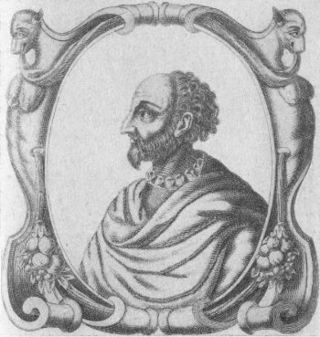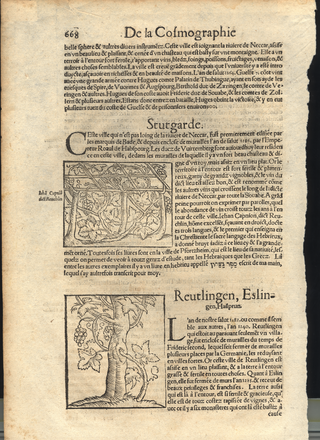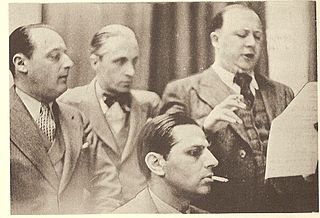Thomas Kyd was an English playwright, the author of The Spanish Tragedy, and one of the most important figures in the development of Elizabethan drama.

Étienne Jodelle, seigneur de Limodin, French dramatist and poet, was born and died in Paris of a noble family. Member of La Pléiade, he will strive to revitalize the principles of ancient Greek and Roman theater during the Renaissance. He was the first to introduce the alexandrine into tragedy in his time, notably with Cléopâtre captive, the first tragédie à l'antique, as well as L'Eugène in comedy. He is recognized as a precursor of the theater which was born in the second half of the 16th century, a convulsive period by Wars of Religion which saw its uncertainties embodied in his work.

The Raigne of King Edward the Third, commonly shortened to Edward III, is an Elizabethan play printed anonymously in 1596, and at least partly written by William Shakespeare. It began to be included in publications of the complete works of Shakespeare only in the late 1990s. Scholars who have supported this attribution include Jonathan Bate, Edward Capell, Eliot Slater, Eric Sams, Giorgio Melchiori and Brian Vickers. The play's co-author remains the subject of debate: suggestions have included Thomas Kyd, Christopher Marlowe, Michael Drayton, Thomas Nashe and George Peele.
Alexandre Hardy was a French dramatist, one of the most prolific of all time. He claimed to have written some six hundred plays, but only thirty-four are extant.

Jean Antoine de Baïf was a French poet and member of the Pléiade.

La Juive is a grand opera in five acts by Fromental Halévy to an original French libretto by Eugène Scribe; it was first performed at the Opéra, Paris, on 23 February 1835.

Jacques Grévin was a French playwright.

17th-century French literature was written throughout the Grand Siècle of France, spanning the reigns of Henry IV of France, the Regency of Marie de' Medici, Louis XIII of France, the Regency of Anne of Austria and the reign of Louis XIV of France. The literature of this period is often equated with the Classicism of Louis XIV's long reign, during which France led Europe in political and cultural development; its authors expounded the classical ideals of order, clarity, proportion and good taste. In reality, 17th-century French literature encompasses far more than just the classicist masterpieces of Jean Racine and Madame de La Fayette.
French Renaissance literature is, for the purpose of this article, literature written in French from the French invasion of Italy in 1494 to 1600, or roughly the period from the reign of Charles VIII of France to the ascension of Henry IV of France to the throne. The reigns of Francis I and his son Henry II are generally considered the apex of the French Renaissance. After Henry II's unfortunate death in a joust, the country was ruled by his widow Catherine de' Medici and her sons Francis II, Charles IX and Henry III, and although the Renaissance continued to flourish, the French Wars of Religion between Huguenots and Catholics ravaged the country.

Bradamante is a fictional knight heroine in two epic poems of the Renaissance: Orlando Innamorato by Matteo Maria Boiardo and Orlando Furioso by Ludovico Ariosto. Since the poems exerted a wide influence on later culture, she became a recurring character in Western art.

François de Belleforest was a prolific French author, poet and translator of the Renaissance.
An overview of the history of theatre of France.
Louis Lacoste, also given as De La Coste was a French composer of the Baroque era. He was a singer, first appearing in the chorus of André-Cardinal Destouches' Issé (1697) then chorus master and leader of the orchestra at the Paris Opéra. He composed several works for the stage, the most successful of which was Philomèle, first performed on 20 October 1705 by the Académie Royale de Musique at the Théâtre du Palais-Royal in Paris, and revived in 1709, 1723, and 1734. Bradamante was a "bruising failure".

Rosine Stoltz was a French mezzo-soprano. A prominent member of the Paris Opéra, she created many leading roles there including Ascanio in Berlioz's Benvenuto Cellini, Marguerite in Auber's Le lac des fées, the title role in Marie Stuart, and two Donizetti heroines, Léonor in La favorite and Zayda in Dom Sébastien.
Simon Bélyard was a French playwright of the second half of the 16th century associated with the city of Troyes.
Monsieur (de) Sallebray was a 17th-century French poet and playwright.
John Scheid is a French historian. A specialist of ancient Rome, he has been a professor at the Collège de France since 2001.

Henri Médus was a French operatic bass.

Michel Zink is a French writer, medievalist, philologist, and professor of French literature, particularly that of the Middle Ages. He is the Permanent Secretary of the Académie des Inscriptions et Belles-Lettres, a title he has held since 2011, and was elected to the Académie française in 2017. In addition to his academic work, he has also written historical crime novels, one of which continues the story of Arsène Lupin.
Cornelia or Pompey the Great, his Fair Cornelia's Tragedy is a 1590 play by Thomas Kyd. The play is about Cornelia Metella, the widow of Pompey. The play ends with Pompey's death and the reactions from his family. Julius Caesar does not appear in person but has a presence throughout. It is an English language adaptation of Robert Garnier's play Cornélie from 1573.











